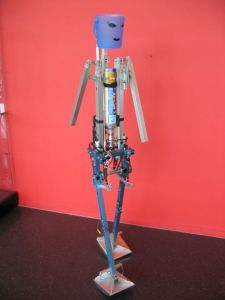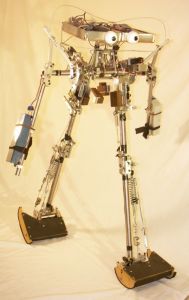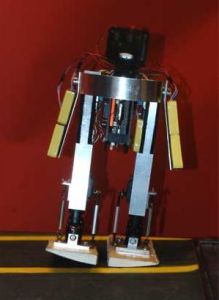Category Archives: Uncategorized
and Tariq Malik
posted: 17 February, 2004, 2 p.m. ET
WASHINGTON D.C. – In what could be described as one small step for a robot, but a giant leap for robot-kind, a trio of humanoid machines were introduced Thursday, each with the ability to walk in a human-like manner.
Each bipedal robot has a strikingly human-like gait and appearance. Arms swing for balance. Ankles push off. Eyeballs are added for effect.
One of the robots, from the Massachusetts Institute of Technology (MIT) is named Toddler for its modest stature and the side-to-side wobble of its stride. Denise, a robot created by researchers at Delft University in the Netherlands, stands about as tall as the average woman.
[…]
All three robots swing their arms in synch with the opposite leg for balance. In most ways, though, they are not as versatile as other automatons. Honda’s Asimo, for example, can walk backward and up stairs. But Asimo requires at least 10 times more power to achieve such feats.
[…]
Robosapien Gets Major Makeover
Inside CES 2005 Robosapien, the monkey-like ‘robot’ that’s been, well, wowing crowds since 2003’s Comdex and last year’s Consumer Electronics Show, is about to get a major update and some cool new friends. Wow Wee, a company launched by former JPL robotics physicist Mark Tilden (he also worked for NASA and DARPA), will introduce a radically redesigned and significantly more expensive Robosapien V2, as well as a brand new Roboraptor and Robopet at this year’s Consumer Electronics Show in Las Vegas.
[…]
Tech Digest: Meet Robosapien’s big brother (ulp)
Last year at CES we got our first glimpse of the Robosapien, that kung-fu kicking, farting robot that become top of every 12 year old’s Christmas wishlist. This time round Robo’s creators Wowee have gone completely bonkers unveiling three new models including, wait for it, Robo’s big brother, Robosapien V2 and a dinosaur to chase him round your lounge. Ten inches taller than the original version, Robosapien has also learned a whole lot of new tricks including the ability to pick up, drop and throw objects. He can also bend over and twist from side to side, so he can now sit, bend, lie down and stand up.
[…]
By John Borland
Staff Writer, CNET News.com
In the back of Carlos Owens’ southern Alaska yard, an 18-foot-tall steel robot is taking shape in the dim light of the winter afternoons.
The 26-year-old Owens is an Anchorage-area steelworker by day. In his own time, he’s hoping to become the creator of a true “mecha”–not a robot, exactly, but a gigantic exoskeleton that can transform its wearer’s motions into eight-foot strides and the devastating sweep of a steel fist.
[…]
Robotory: “Honda Reveals Technologies Next-Generation ASIMO” : Photos Gallery !
Honda Worldwide | HDTV | ASIMO
ASIMO (II) Videos !
| Honda Reveals Technologies Next-Generation ASIMO |
TOKYO, Japan, December 15, 2004 – Honda Motor Co., Ltd. today announced the development of new technologies for the next-generation ASIMO humanoid robot, targeting a new level of mobility that will better enable ASIMO to function and interact with people by quickly processing information and acting more nimbly in real-world environments.
Key technologies include:
| 1) | “Posture Control” technology* making it possible to run in a natural human-like way |
| 2) | “Autonomous Continuous Movement” technology enabling flexible route to destination |
| 3) | Enhanced visual and force sensor technologies enabling smoother interaction with people |
1.Posture Control technology:
| The combination of newly developed high-response hardware and the new Posture Control technology enables ASIMO to proactively bend or twist its torso to maintain its balance and prevent the problems of foot slippage and spinning in the air, which accompany movement at higher speeds. ASIMO is now capable of running at a speed of 3km/hour. In addition, walking speed has been increased from the previous 1.6 km/hour to 2.5 km/hour. |
2.Autonomous Continuous Movement technology:
| The next-generation ASIMO can maneuver toward its destination without stopping by comparing any deviation between the input map information and the information obtained about the surrounding area from its floor surface sensor. ASIMO can now autonomously change its path when its floor surface sensor and visual sensors located in its head detect obstacles. |
3.Enhanced visual sensor and force sensor technologies allow for smoother interaction with people:
| By detecting people’s movements through visual sensors in its head and force (kinesthetic) sensors which have been newly added to its wrists, ASIMO can now move in sync with people allowing it to give or receive an object, shake hands in concert with a person’s movement and step forward or backward in response to the direction its hand is pulled or pushed. | |
|
By continuing to advance these new technologies, Honda will pursue development of an ASIMO that will be useful to people. |
|
Key specifications of the new model:
| 1. | Running speed: | 3km/hour (airborne time: 0.05 second) |
| 2. | Normal walking speed: | 2.5km/h (current model: 1.6km/h) |
| 3. | Height: | 130cm (current model: 120cm) |
| 4. | Weight: | 54kg (current model: 52kg) |
| 5. | Continuous operating time: | 1hour (current model: 30 min) |
| 6. | Operating degrees of freedom: |
Total 34 degrees of freedom (current model: Total 26) |
| · Hip rotational joint: | Increased walking speed was achieved by the proactive rotation of the hips in addition to swinging of the arms, which cancel the reaction force generated when the legs swing forward during running or walking. |
|
| · Wrist bending joint: | Due to two additional axes in each wrist, the movement of the wrist area is more flexible. |
|
| · Thumb joint: | Previously, one motor operated all five fingers. With addition of a motor that operates the thumb independently, ASIMO can now hold objects of various shapes. |
|
| · Neck joint: | With an additional axis added to its neck joint, ASIMO’s expressiveness has been enhanced. |
| * | More about the new Posture Control technology: In order to realize “running,” two major obstacles had to be overcome. One was an accurate leap and the absorption of the landing impact, and the second was prevention of the slipping and spinning which accompany movement at higher speeds. |
| 1. Accurate leap and absorption of landing impact: | |
| In order to run, a robot has to be able to repeat the movements of pushing off the ground, swinging its legs forward, landing within a very short time cycle and without any delay, absorbing the instantaneous impact shock of landing. With a newly developed high-speed processing circuit, highly-responsive and high-power motor drive unit, in addition to light-weight and highly rigid leg structure, Honda realized highly accurate and responsive hardware with performance levels more than four times faster compared to that of the previous model. |
| 2. Prevention of spinning and slipping: | |
| Due to reduced pressure between the bottom of the feet and floor, spinning and slipping are more likely to happen right before the foot leaves the floor and right after the foot lands on the floor.
Overcoming the problem of spinning and slipping was the biggest control element challenge related to increasing running speed. Combining Honda’s independently developed theory of bipedal walking control with proactive bending and twisting of the torso, Honda developed a new control theory which enables stable running, while preventing slipping. Through these technologies, ASIMO is now capable of smooth human-like running at a speed of 3km/hour. Walking speed was increased from the previous 1.6 km/hour to 2.5 km/hour. When a human runs, the step cycle is 0.2 to 0.4 seconds depending on one’s speed, and the airborne time, when both feet are off the ground, varies between 0.05 to 0.1 seconds. The step cycle of ASIMO is 0.36 seconds with an airborne time of 0.05 seconds, which are equivalent to that of a person jogging. |
iFBot Official Site – Press release (japanese)
???????
????????????
???????????????
?????????
[…]


